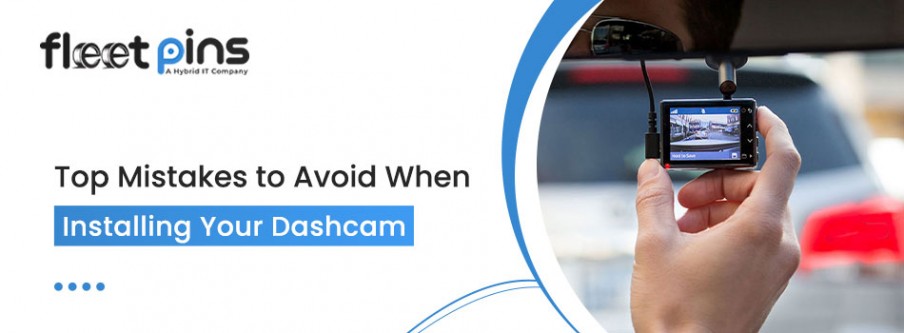
- On 2024-07-24
Top Mistakes to Avoid When Installing Your Dashcam
Dashcams have become essential tools for fleet management. Fleet dash cam solution offering protection against fraudulent claims, providing evidence in the event of accidents, and helping to monitor driver behavior. However, installing a dashcam isn't always straightforward. Avoiding common mistakes can ensure your dashcam functions optimally and provides the most value. Here are the top mistakes to avoid when installing your dashcam.
Key Installation Mistakes to Avoid
Here are the top Mistakes to Avoid When Installing Your Dashcam:
Choosing the Wrong Placement
One of the most common mistakes is improper placement of the dashcam. Mounting it in the wrong spot can obstruct the driver's view or capture poor-quality footage. The best place to mount a dashcam is typically behind the rearview mirror, where it can record both the road ahead and the vehicle's interior without obstructing the driver’s field of vision. Ensure the lens is positioned to capture a clear, wide view of the road.
Not Using the Correct Power Source
Dashcams can be powered in several ways, including via the cigarette lighter socket or hardwired into the vehicle’s electrical system. Using the cigarette lighter socket might be convenient. But it can lead to issues like the dashcam turning off when the vehicle is off or battery drain.
Hardwiring the dashcam provides a more reliable power source and allows the camera to function even when the vehicle is turned off. However, improper installation can damage the vehicle’s electrical system. It’s best to follow the manufacturer's instructions or seek professional installation.
Ignoring the Importance of Cable Management
For fleet dash cam solution poor cable management can lead to a messy interior and potential safety hazards. Dangling wires can obstruct the driver’s view or get tangled with vehicle controls. Ensure cables are neatly tucked away, using cable clips or running them along the vehicle's trim. This not only maintains a clean look but also prevents cables from being accidentally pulled out.
Forgetting to Format the Memory Card Regularly
Dashcams rely on memory cards to store footage, and these cards need regular formatting to maintain performance and reliability. Forgetting to format the memory card can lead to corrupted files or the dashcam failing to record. It’s advisable to format the memory card at least once a month. Additionally, using high-quality memory cards recommended by the dashcam manufacturer can prevent data loss and ensure smooth recording.
Overlooking Firmware Updates
Firmware updates for dashcams often include important fixes and new features. Ignoring these updates can leave your dashcam vulnerable to bugs and performance issues. Regularly check for firmware updates on the manufacturer's website and install them to keep your dashcam running smoothly and efficiently.
Not Setting the Correct Date and Time
Incorrect date and time settings can create issues when you need to use the footage as evidence. Ensure the date and time are set correctly during installation and adjust them for daylight saving changes or after traveling across time zones. This ensures that the timestamp on the recordings is accurate and reliable.
Neglecting to Adjust the Camera Angle
Simply mounting and using a dash cam is not enough; you must also adjust the camera angle to ensure it captures the desired view. A dashcam aimed too high may miss important details on the road, while one aimed too low might capture too much of the dashboard. Take the time to adjust the camera angle after installation, and review the footage to confirm it provides a comprehensive view of the road and surroundings.
Ignoring Legal Requirements and Privacy Concerns
Different regions have varying laws regarding dashcam use, especially concerning privacy. Some places require notifying passengers that they are being recorded, while others may restrict the use of dashcams altogether. Ensure you are aware of and comply with local regulations to avoid legal issues while dash cam installation. Additionally, be mindful of privacy concerns and ensure the dashcam is used ethically.
Overlooking Temperature and Environment Conditions
Dashcams are exposed to various environmental conditions, and not all models are designed to withstand extreme temperatures. Overheating can cause the dashcam to malfunction, while very cold temperatures can affect battery performance. Choose a dashcam suitable for your vehicle’s operating environment and consider models with built-in temperature protection features.
Failing to Test the Dashcam After Installation
After dash cam installation, it’s crucial to test it to ensure everything is working correctly. Check the footage quality, verify that the device is recording properly, and ensure all features (like GPS and Wi-Fi) are functioning. Testing the dashcam immediately after installation can save you from discovering issues when it’s too late to correct them.
Conclusion
Installing a dashcam correctly involves more than just attaching it to your windshield. By avoiding these common mistakes, you can ensure your dashcam operates efficiently, providing you with reliable footage and peace of mind. Proper placement, power source, cable management, and regular maintenance are key to maximizing the benefits of your dashcam.




